Introduction
- The environment impacts infant health;
- Air pollution is a problem in urban and rural settings;
- The lack of caretakers’ knowledge endangers infants.
Infant health relies on a variety of factors, the surrounding environment being one of them. For example, the quality of air and the presence of pollutants are among some of the most influential aspects of the environment. Adults and children suffer from allergies, asthma, and respiratory diseases every year (World Health Organization [WHO], 2018a). However, caretakers may not recognize some immediate risks or lack awareness of how air pollution can be challenged. This presentation offers some information about the damage of air pollution and presents a health promotion plan with helpful resources and evidence from research.

Environmental Factor: Air Pollution
Indoor air pollution sources
- Fuel for cooking: kerosene, coal, wood, crop waste, animal dung;
- Tobacco;
- Poor ventilation.
Outdoor air pollution sources
- Vehicle fuel fumes;
- Waste emissions;
- Ozone;
- Smog.
Air pollution refers to the contents of indoor and outdoor air and the presence of toxic particles and gases that negatively affect one’s health. For example, one of the known pollutants is tobacco – smoking is widely regarded as harmful to both active and passive smokers (World Health Organization [WHO], 2018b). Another risk factor is fuel fumes from vehicles or machinery (Knittel, Miller, & Sanders, 2016). Nonetheless, many types of pollution are not as commonly recognized, including lead, soot, biomass fuel fumes, and ozone. Many mothers and children are exposed to these substances without knowing their harmful effects.
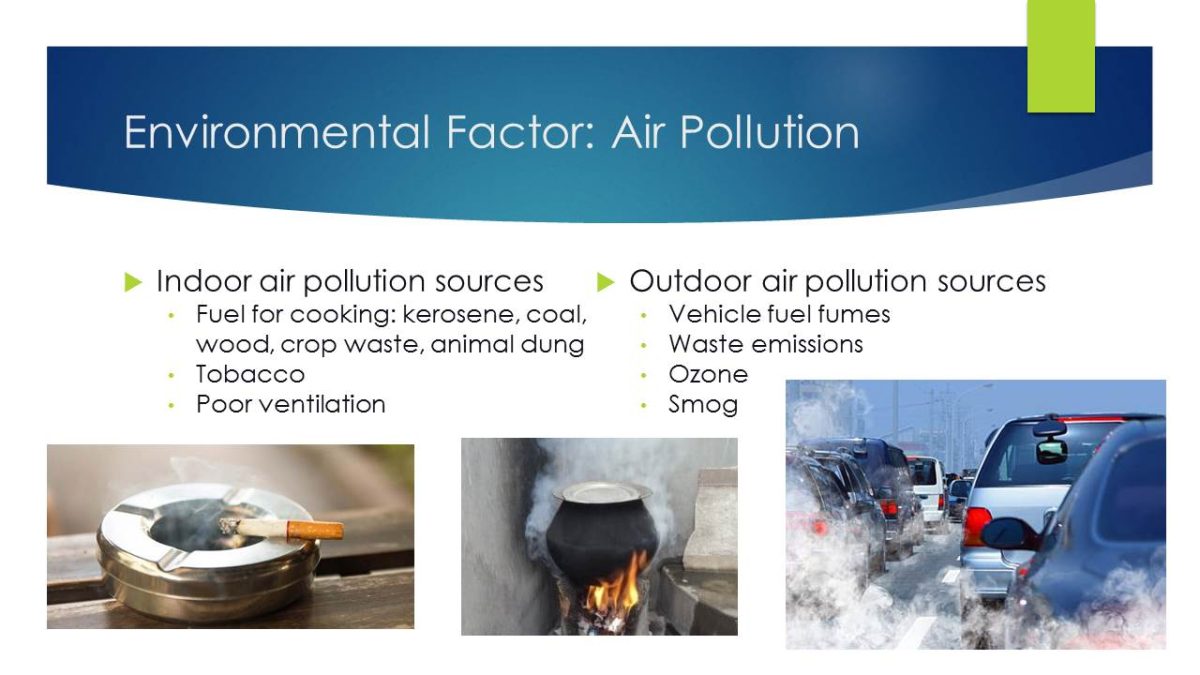
The Impact of Air Pollution
Infant mortality
- 45% of infant deaths from pneumonia are due to poor indoor air quality (WHO, 2018b);
- Childhood pneumonia leads to lung and heart diseases, cancer;
- Pollution increases infant mortality.
Long-term impacts
- Asthma;
- Allergies;
- Bronchitis.
For infant’s fragile health, air pollution can lead to long-term damage. Poor household air quality is responsible for almost half of deaths from pneumonia for children under five years old (WHO, 2018b). It also doubles the chances of developing pneumonia, which can entail permanent lung damage, heart problems, and cancer (WHO, 2018b). In low- and middle-income countries and all areas that continue to use kerosene, wood, and other natural sources for heating and cooking, pneumonia remains one of the leading causes of infant death. However, developed countries also suffer from high pollution rates due to the abundance of manufacturing and transportation. Long-term exposure to high levels of nitrogen dioxide, a gas that is produced during power generation, heating, and various engine’s work, increases the rates of bronchitis and asthma in children (WHO, 2018a). According to Rich (2017), air pollution is directly connected to the levels of infant mortality regardless of the country’s economic prosperity or healthcare quality.
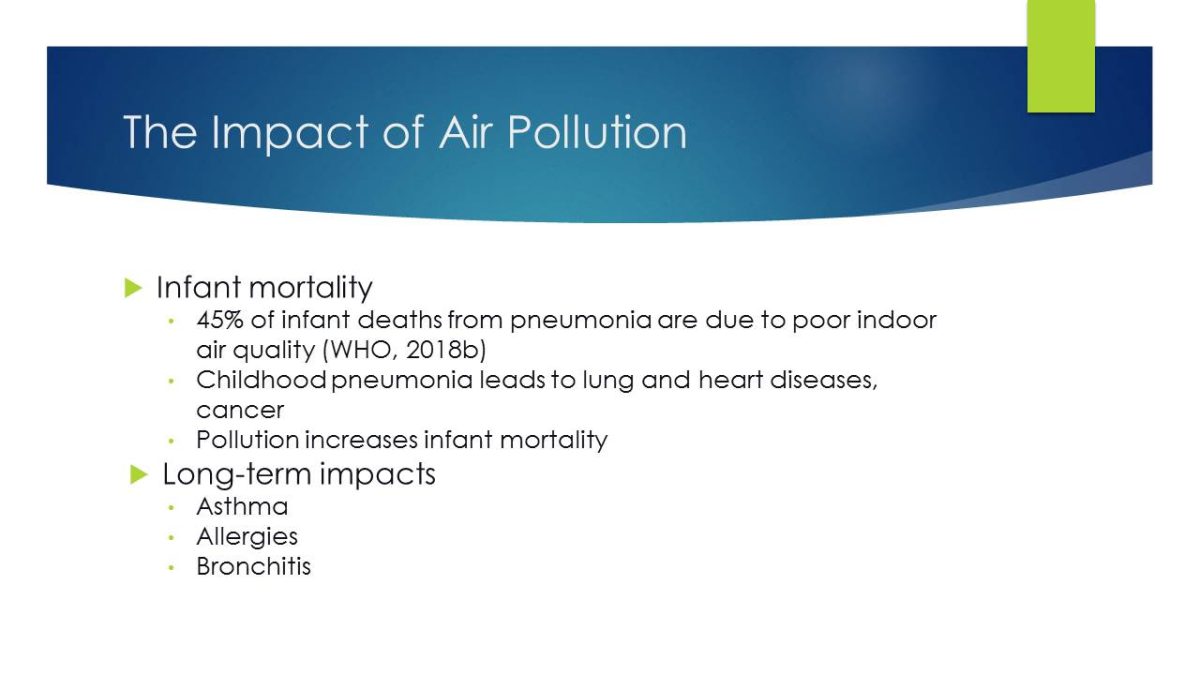
Health Promotion Plan
Plan’s goals
- Educate caregivers about sources of pollution;
- Provide strategies for safety promotion;
- Share resources with additional information.
Carbon monoxide (CO)
- Gas, kerosene heaters;
- Tobacco;
- Chimneys.
The goal of this health promotion plan is to educate caretakers about sources of pollution and strategies to protect infants from them. Three types of pollution are the focus of the plan – carbon monoxide, nitrogen dioxide and ozone, and soot.Carbon monoxide is an odorless gas that is produced by kerosene and gas heaters, wood stoves, fireplaces, generators, tobacco smoke, and vehicle engines (Apte & Salvi, 2016). Carbon monoxide poisoning leads to respiratory conditions, headaches, nausea, and death. This gas affects the quality of both indoor and outdoor air. To protect infants from CO poisoning, caregivers should annually check appliances that burn fuel, including chimneys and flues. Next, gas ovens and burners cannot be used for heat, and kerosene and gas heaters have to be properly ventilated. To prevent accidents, these heaters should be turned off during sleep. A CO alarm should be installed to monitor the levels of CO in the room.
Nitrogen dioxide and ozone
- Outside air pollutants;
- Hot, sunny weather;
- Power generators and heaters.
Nitrogen dioxide and ozone can make respiratory symptoms worse and make breathing difficult for infants. The concentration of these gases in the outdoor air changes with location and climate – ozone levels rise in polluted areas with hot temperatures and sunny weather (AirNow, 2020). To protect young children from this type of pollution, caretakers should monitor the quality of air using a tracker. During days with high levels of ozone, infants should spend time indoors to limit exposure to polluted air. Otherwise, any outdoor activities should be planned for mornings or evenings, when the levels are usually lower. To limit the production of nitrogen dioxide, households may avoid power generation and heating that involves combustion.
Soot
- Small particles traveling through the air;
- The consequence of other pollutants.
Similar to the other sources of air pollution, soot appears from vehicles with combustion engines, heating, and cooking with gas and wood. The gasses described above interact with air components and create tiny bits that travel through the air or concentrate on surfaces. Inhaling soot, an infant may develop respiratory problems such as asthma (AirNow, 2020). To ensure children’s safety, caretakers can clean their home as often as possible and make sure that rooms with heaters or cooking appliances are ventilated.
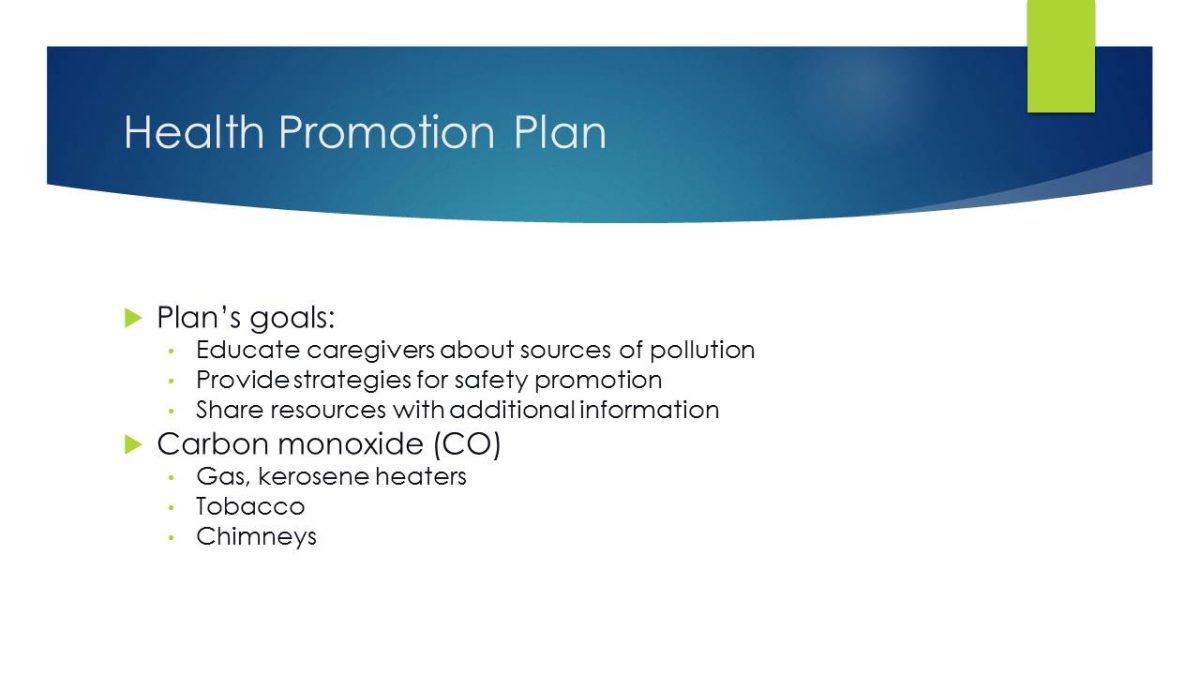
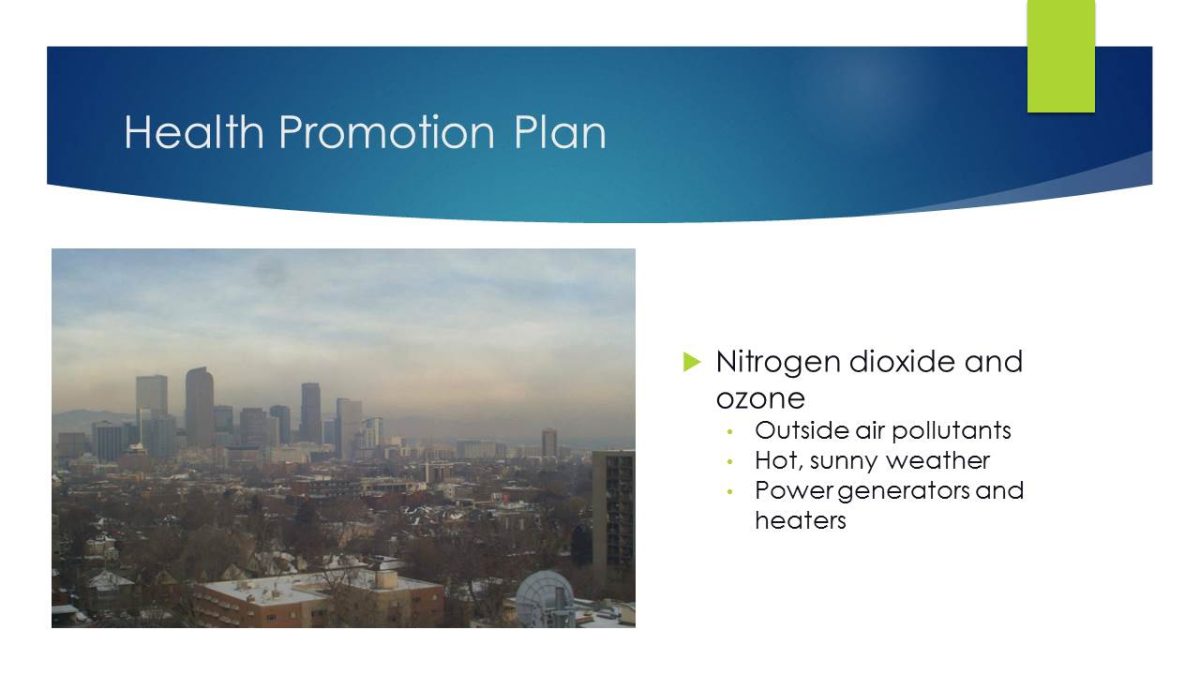
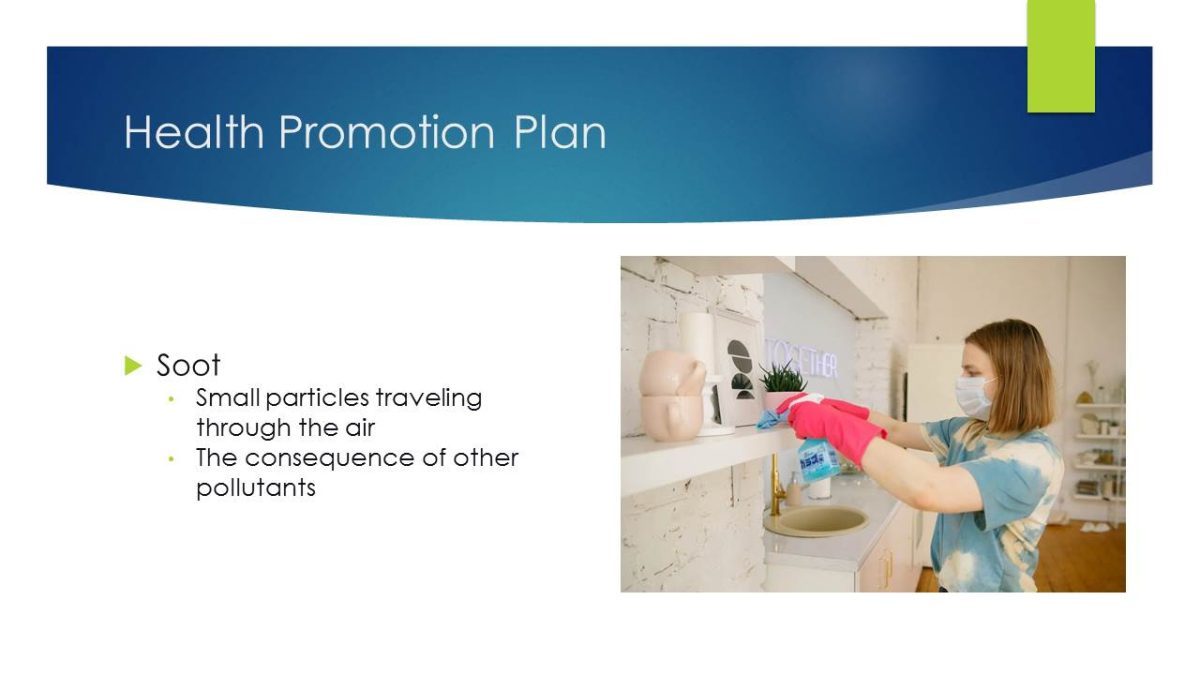
Examples from Research
- Awareness campaigns are a pillar of change (Rich, 2017);
- Air pollution should be targeted at all levels;
- Knowledge can turn into policy.
According to Rich (2017), awareness-raising is one of the most critical interventions for combating the impact of air pollution on infant health. Knowledge is vital at all levels of influence; for example, caretakers can use the promotion plan outline above to assess their home and other environments for infant safety and accident prevention. Furthermore, they may feel encouraged to create and support new policy or other local, state, or national action to lower the level of pollution. Advocacy for a lifestyle change, namely using less toxic fuel and implementing clean energy sources, is another outcome of knowledge projects.
- Policy leads to positive change;
- Bans and specific requirements lower mortality;
- Low emission zones, better transport, and clean fuel are impactful.
Nevertheless, individual action cannot be the only path for meaningful change. As Lee, Yoo, and Nam (2018) find, such national programs as the Clean Air Act in South Korea, can make urban, highly polluted regions cleaner and less toxic for infants. The authors find a link between the act and infant mortality rates, noting a positive impact of reducing air pollution on a major scale.
Burns et al. (2020) also find that bans on the use of coal and wood have some positive effects on mortality, along with specific vehicle standards for emission levels and engine types. Therefore, collective action is necessary to protect infants from the long-term effects of pollution.
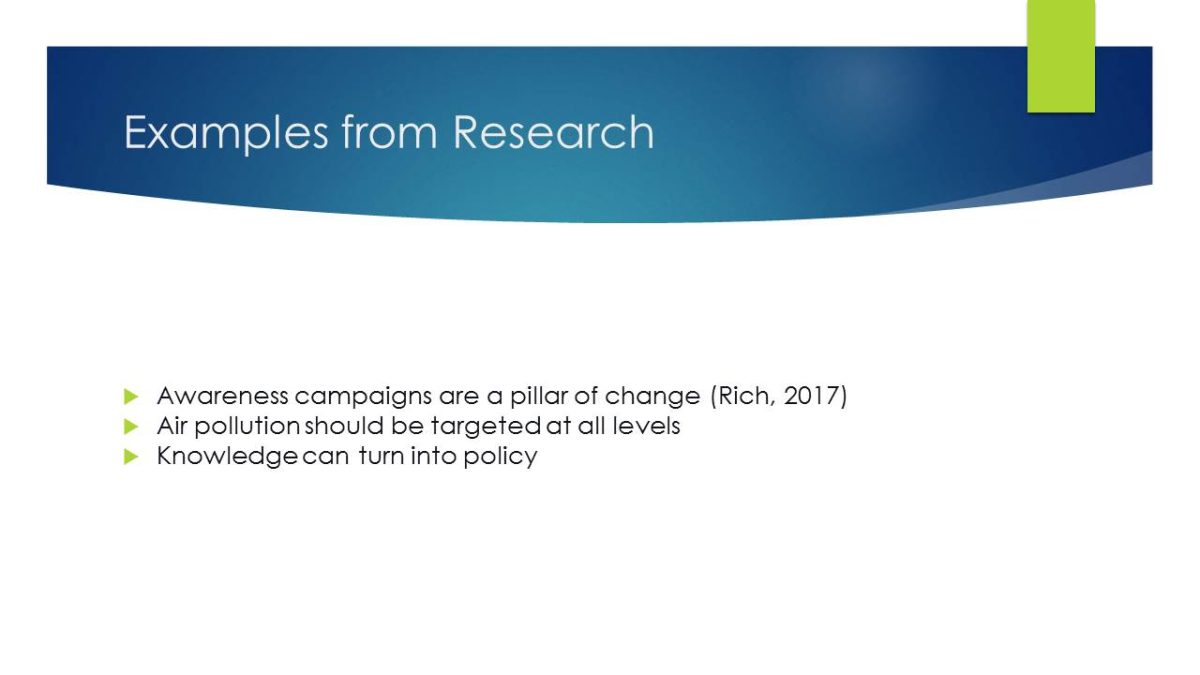
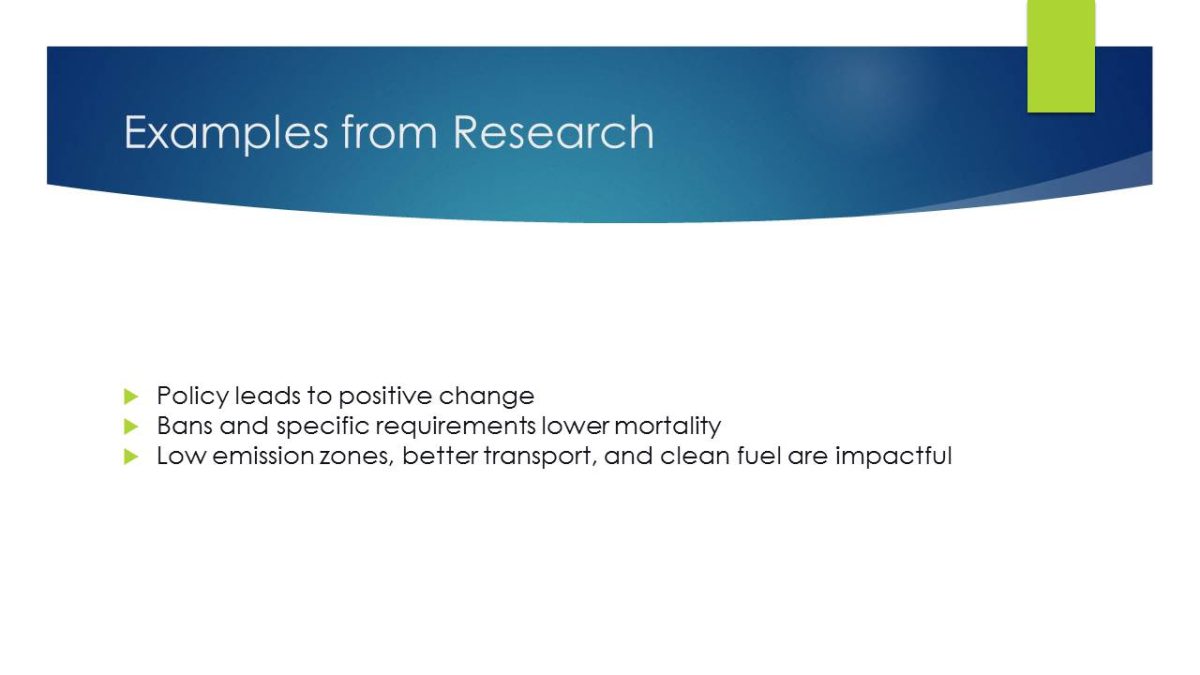
Community Resources
Air Quality Index
- Website: www.airnow.gov;
- Daily index and forecasts for air quality.
U.S. Environmental Protection Agency (EPA)
- Website: www.epa.gov;
- A list of ideas for accident prevention.
The first community resource is the website for the United States Air Quality Index. This national project allows people to check the quality of outside air in their city and state (AirNow, 2020). This resource is valuable for areas where ozone pollution is a serious issue. The site also offers air quality forecasts and recommendations for activities during high-risk times.
The second resource is the online collection of advice for caretakers to protect infants and young children from environmental threats, including air pollution (Unites States Environmental Protection Agency, 2019). Apart from mentioning recommendations listed in the health promotion plan, it also offers suggestions for lead and mercury poisoning, breathing techniques, and clean transport ideas. This is a helpful guide for individual activities that is easy to share with friends and coworkers, and it provides evidence-based information.
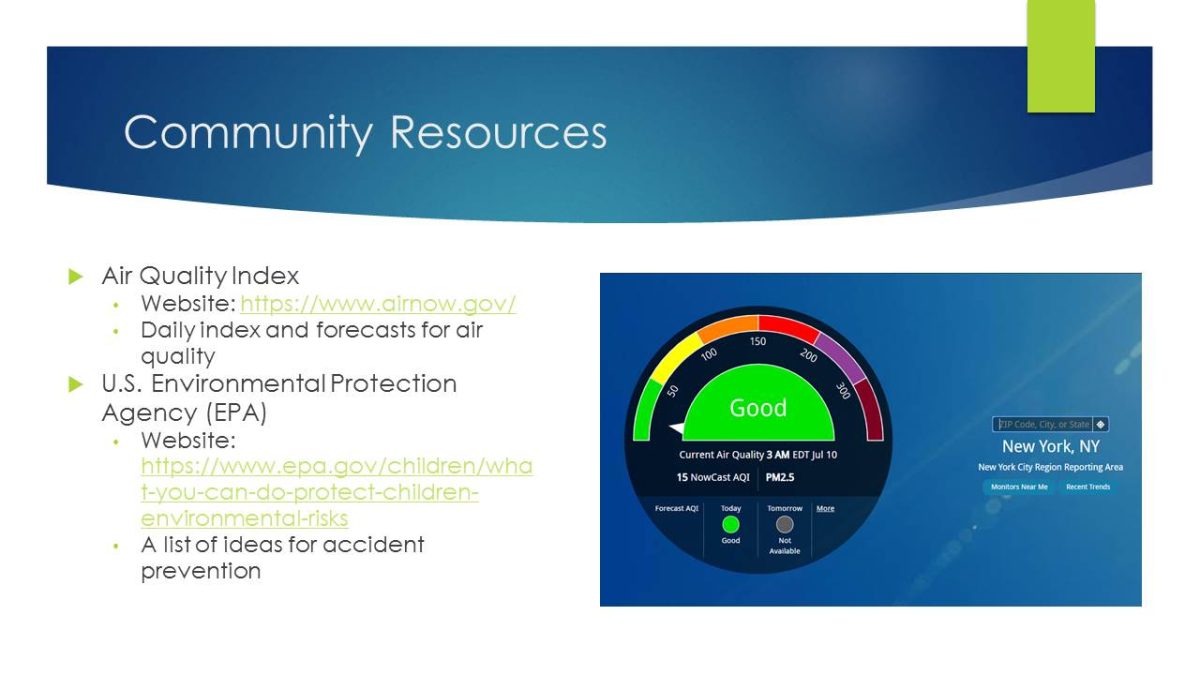
Conclusion
- Air pollution is a reversible problem;
- Some sources of heating and cooking expose infants to long-term health risks;
- Awareness-raising is essential for improving air quality.
Indoor and outdoor air pollution is a well-known problem among researchers, but many risk factors are unknown to people around the world. Caretakers, concerned with infant health, should consider various sources of pollution, including heating and cooking appliances and fuel sources that produce toxic gases and particles. Infant’s respiratory systems are fragile, and breathing in carbon monoxide or soot particles can damage their lungs and hearts in the long term. An awareness health promotion program that explains the dangers of these substances and ways to keep the air clean is a great way to protect infants from pollution.

References
AirNow. (2020). Using the Air Quality Index. Web.
Apte, K., & Salvi, S. (2016). Household air pollution and its effects on health. F1000Research, 5. Web.
Burns, J., Boogaard, H., Polus, S., Pfadenhauer, L. M., Rohwer, A. C., van Erp, A. M., … Rehfuess, E. A. (2020). Interventions to reduce ambient air pollution and their effects on health: An abridged Cochrane systematic review. Environment International, 135, 105400.
Knittel, C. R., Miller, D. L., & Sanders, N. J. (2016). Caution, drivers! Children present: Traffic, pollution, and infant health. Review of Economics and Statistics, 98(2), 350-366.
Lee, S., Yoo, H., & Nam, M. (2018). Impact of the Clean Air Act on air pollution and infant health: Evidence from South Korea. Economics Letters, 168, 98-101.
Rich, D. Q. (2017). Accountability studies of air pollution and health effects: Lessons learned and recommendations for future natural experiment opportunities. Environment International, 100, 62-78.
Unites States Environmental Protection Agency. (2019). What you can do to protect children from environmental risks. Web.
World Health Organization. (2018a). Ambient (outdoor) air pollution. Web.
World Health Organization. (2018b). Household air pollution and health. Web.